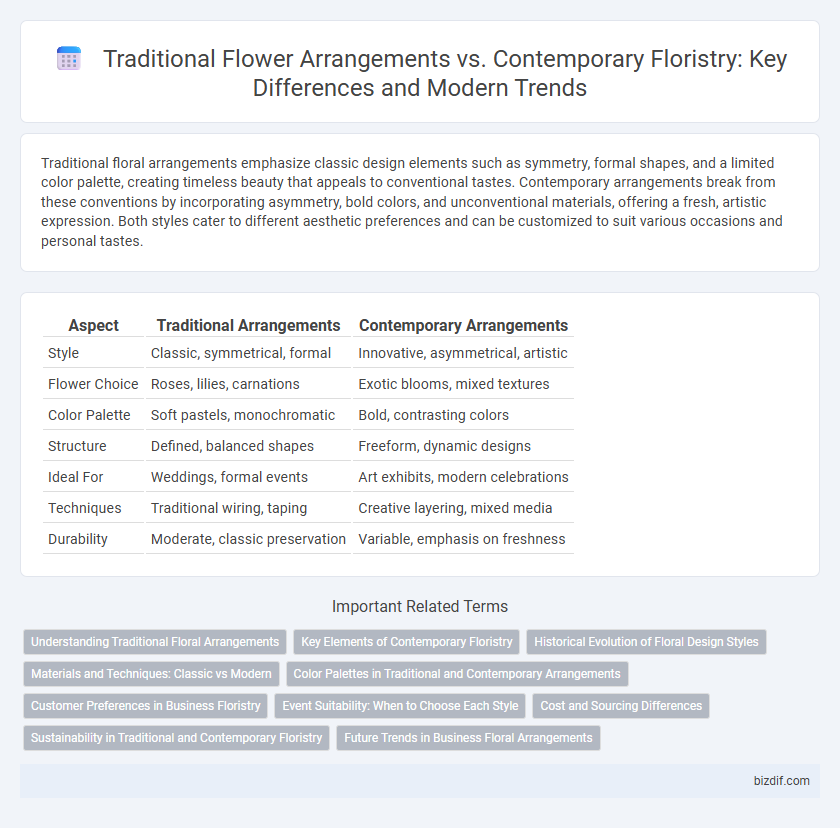Traditional floral arrangements emphasize classic design elements such as symmetry, formal shapes, and a limited color palette, creating timeless beauty that appeals to conventional tastes. Contemporary arrangements break from these conventions by incorporating asymmetry, bold colors, and unconventional materials, offering a fresh, artistic expression. Both styles cater to different aesthetic preferences and can be customized to suit various occasions and personal tastes.
Table of Comparison
| Aspect | Traditional Arrangements | Contemporary Arrangements |
|---|---|---|
| Style | Classic, symmetrical, formal | Innovative, asymmetrical, artistic |
| Flower Choice | Roses, lilies, carnations | Exotic blooms, mixed textures |
| Color Palette | Soft pastels, monochromatic | Bold, contrasting colors |
| Structure | Defined, balanced shapes | Freeform, dynamic designs |
| Ideal For | Weddings, formal events | Art exhibits, modern celebrations |
| Techniques | Traditional wiring, taping | Creative layering, mixed media |
| Durability | Moderate, classic preservation | Variable, emphasis on freshness |
Understanding Traditional Floral Arrangements
Traditional floral arrangements emphasize classic design principles such as symmetry, balance, and proportion, often featuring formal shapes like rounds and cascades. They typically use a limited color palette with flowers like roses, lilies, and carnations to evoke timeless elegance and cultural symbolism. Understanding traditional arrangements requires knowledge of historical styles, floral mechanics, and the cultural significance of flower choices.
Key Elements of Contemporary Floristry
Contemporary floristry emphasizes minimalism, asymmetry, and the use of unconventional materials like succulents and dried botanicals, contrasting sharply with the dense, symmetrical designs typical of traditional arrangements. Key elements include bold, unexpected color contrasts, innovative container choices, and a focus on negative space to create visually striking compositions. This modern approach prioritizes artistic expression and individuality, often integrating natural textures and geometric forms for dynamic impact.
Historical Evolution of Floral Design Styles
Traditional floral arrangements are rooted in centuries-old design principles emphasizing symmetry, balance, and formal structure, often inspired by Victorian and European influences. Contemporary arrangements evolved throughout the 20th century, embracing minimalism, asymmetry, and innovative use of materials reflecting modern artistic movements such as Ikebana and abstract art. The historical evolution of floral design styles showcases a transition from rigid, ornate compositions to expressive, personalized creations that highlight individual creativity and cultural diversity.
Materials and Techniques: Classic vs Modern
Traditional floral arrangements use natural materials like roses, lilies, and carnations, combined with techniques such as symmetrical shaping and tight grouping to emphasize formality and timeless elegance. Contemporary arrangements incorporate unconventional elements like succulents, dried flowers, and mixed media, adopting asymmetry, minimalism, and innovative wire framing for a modern aesthetic. The choice of materials and methods in floristry directly influences the style, evoking either classic beauty or avant-garde creativity.
Color Palettes in Traditional and Contemporary Arrangements
Traditional floral arrangements typically showcase a rich, harmonious color palette featuring deep reds, soft pastels, and classic whites, emphasizing balance and symmetry. Contemporary arrangements embrace bold, contrasting colors such as vibrant oranges, electric blues, and bright yellows, often combining unexpected hues to create dynamic visual impact. The color choices in contemporary designs prioritize innovation and artistic expression, while traditional palettes evoke timeless elegance and formality.
Customer Preferences in Business Floristry
Customer preferences in business floristry reveal distinct trends between traditional and contemporary arrangements, with many seeking timeless elegance in classic floral designs featuring roses, lilies, and chrysanthemums. Contemporary arrangements attract clients desiring innovative aesthetics using exotic blooms, asymmetrical shapes, and mixed textures to reflect modern tastes. Understanding these preferences enables florists to tailor services, enhancing customer satisfaction and increasing sales in competitive markets.
Event Suitability: When to Choose Each Style
Traditional floral arrangements suit formal events such as weddings and corporate gatherings, emphasizing symmetry, classic blooms like roses and lilies, and structured designs. Contemporary arrangements work best for modern celebrations, art events, and casual parties, featuring asymmetrical shapes, bold colors, and unconventional flowers or materials. Choosing the right style depends on the event's tone, desired aesthetic, and setting to ensure floral decor enhances the overall atmosphere.
Cost and Sourcing Differences
Traditional floral arrangements typically involve locally sourced flowers like roses, lilies, and carnations, resulting in moderate costs due to seasonal availability and established supply chains. Contemporary arrangements often incorporate exotic or imported blooms, such as proteas or orchids, which increase overall expenses due to higher sourcing and transportation fees. Cost variations also arise from differing design complexities, with traditional styles emphasizing classic symmetry, while contemporary arrangements favor innovative, sometimes labor-intensive methods.
Sustainability in Traditional and Contemporary Floristry
Traditional floral arrangements often use locally sourced, seasonal flowers that minimize transportation emissions and promote sustainable growing practices, while contemporary arrangements emphasize innovative materials such as recycled elements and eco-friendly floral foam alternatives to reduce environmental impact. Both styles prioritize sustainability, with traditional floristry focusing on natural preservation techniques and contemporary designs incorporating zero-waste methods and biodegradable components. Choosing sustainable practices in both traditional and contemporary floristry supports biodiversity, reduces carbon footprints, and encourages longevity in floral artistry.
Future Trends in Business Floral Arrangements
Future trends in business floral arrangements emphasize innovative designs that blend traditional craftsmanship with modern aesthetics, incorporating sustainable materials and eco-friendly practices. Digital customization tools and AI-driven design software enable florists to create personalized, impactful displays that cater to evolving corporate branding needs. Embracing technology and environmental consciousness will define the competitive edge in the floral industry's future market.
Traditional Arrangements vs Contemporary Arrangements Infographic

 bizdif.com
bizdif.com